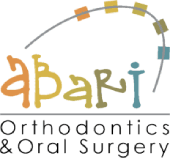
Most of the orthodontic services at Abari Orthodontics & Oral Surgery fall into two main categories: Phase 1 and Phase 2.
Childhood Interceptive Orthodontic Services
Phase 1 orthodontics is the treatment of children aged 5-12. Phase 1 is early intervention to reduce both the treatment time and cost of orthodontics. 80% of phase 1 treatment is completed before adult teeth are present, using natural growth to prevent crowding.
The success of Phase 1 treatment depends upon the cooperation of your child, with younger children often being more willing to wear appliances. Early orthodontic treatment creates beautiful smiles and healthy jaws, prevents snoring and speech problems, and removes the need for future extractions of permanent teeth.
Interceptive Orthodontics Heads Off Problems Early
Conventional wisdom argues that orthodontic treatment shouldn’t start until all the adult teeth have grown in, but some issues with bite, alignment, and facial development can show up long before those teeth do. That’s where interceptive or Phase 1 orthodontics comes in.
An orthodontist can help your child’s jawbones grow properly to have more room for the adult teeth and provide the structure for a healthier bite. Correcting problems like malocclusions (bad bites) as they appear makes future orthodontic services much faster and easier — and, in some cases, unnecessary!
Causes of Malocclusions in Children
Interceptive orthodontic services seek to correct problems with jaw growth and damage from harmful habits such as thumb sucking, nail-biting, tongue thrusting, and mouth breathing. Each of these habits contributes to bite problems such as a narrow upper arch, an underdeveloped lower jaw, a deep bite, and an open bite, as well as dental crowding, which in turn can make it difficult to chew and swallow effectively and speak clearly.
The purpose of Phase 1 treatment is to stop those habits if they persist or repair the damage so that the adult teeth can grow in where they should.
Common Phase 1 Treatment
One of the most noticeable differences between Phase 1 and Phase 2 orthodontic services is that Phase 1 is less focused on actual braces. Those typically come later, if they are still needed. Some of the treatments commonly used in Phase 1 include:
- Upper jaw expansion to eliminate a crossbite
- Expansion of one or both jaws to create more room for adult teeth
- Early extraction of specific baby teeth to help adult teeth come in properly
- Keeping space open for permanent teeth after premature loss of a baby tooth
- Reduction of upper front teeth protrusion to protect from trauma
Phase 2 Orthodontics
Phase 2 Orthodontics is the treatment of adults and children 12 and older. Phase 2 straightens teeth using orthodontic braces or clear aligners. This process is most successful when it immediately follows phase 1, and generally takes 1 to 2 years. Here at Abari Orthodontics & Oral Surgery, we offer different types of braces to treat orthodontic problems in teens and adults.
Adults Can Get Invisalign Too!
If you’re out of your teens, you might think you missed your chance for straight teeth, but that’s not true! Modern orthodontic services, including Invisalign, is for adults as well as teens. And even if you had braces before, your teeth might still shift over time, which is another reason to consider treatment as an adult.
The Biology Of Shifting Dental Alignment
So what’s actually happening on the cellular level during orthodontic treatment? Specialized cells called osteoclasts and osteoblasts respond to the pressure around the periodontal membrane (the pocket of gum tissue connecting the tooth’s root to the jaw bone). Osteoclasts break down the bone tissue so that the tooth can move, while osteoblasts gradually form new bone tissue behind it. So it’s not just your teeth moving into position; your jawbones are reshaping themselves too!
Beyond Phase 2 Orthodontic Services
Your teeth still remember where they used to be for a while after the braces come off, which is why it’s so important for you to remember to wear your retainers as directed. Retainers will help your teeth get used to their new position, and they’ll prevent unrelated shifting that happens to most people naturally over the course of time.

